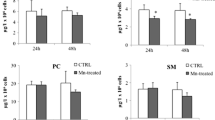Abstract—2-Hexadecenal is an unsaturated aldehyde that is formed during the free radical destruction of sphingolipids under oxidative stress and exhibits biological activity by inhibiting proliferation and inducing apoptosis. The results of studying the modifying effect of this aldehyde on the redox processes that occur in rat C6 glioma cells are presented. It has been shown that cultivation of cells with 2-hexadecenal (at concentrations from 3.5 to 35 μmol/L) leads to a significant increase in the yield of menadione-induced superoxide anion radicals; and at higher concentrations, to its decrease. It has been revealed that under the action of 2-hexadecenal on cells, the additional production of \({\text{O}}_{2}^{{\centerdot - }}\) is completely suppressed in the presence of inhibitors of stress-activated MAP kinases involved in apoptosis triggering, such as JNK, p38, and ERK1/2. The modifying effects of 2-hexadecenal begin to occur at the early stages of its interaction with cells, which is manifested in the increased production of superoxide anion radicals by mitochondria and a decrease in the intracellular level of reduced glutathione. It has been suggested that the modification of the redox state of C6 cells occurs at the initial stage of the intracellular signaling process, in which 2-hexadecenal plays the role of a signaling molecule.




Similar content being viewed by others
REFERENCES
N. Bartke and Y. A. Hannun, J. Lipid Res. 50, 591 (2009).
R. P. Rao, N. M. Vaidyanathan, et al., J. Lipids. 2013, Article ID 178910, 12 (2013).
J. Newton, S. Lima, M. Maceyka, et al., Exp. Cell Res. 333 (2), 195 (2015).
N. C. Hait and A. Maiti, Mediators Inflamm. 2017, Article ID 4806541, 17 (2017).
A. G. Lisovskaya, O. I. Shadyro, and I. P. Edimecheva, Lipids 46, 271 (2011).
A. G. Lisovskaya, I. P. Edimecheva and O. I. Shadyro, Photochem. Photobiol. 88, 899 (2012).
V. V. Brahmbhatt, F.-F. Hsu, J. L.-F. Kao, et al., Chem. Phys. Lipids 145, 72 (2007).
O. Shadyro, A. Lisovskaya, G. Semenkova, et al., Lipid Insights 8, 1 (2015).
A. Kumar, H. S. Byun, R. Bittman, et al., Cell Signal. 23, 1144 (2011).
F. Schumacher, C. Neuber, H. Finke, et al., J. Lipid Res. 58, 1648 (2017).
P. Upadhyayaa, A. Kumar, H. Byun, et al., Biochem. Biophys. Res. Commun. 424 (1), 18 (2012).
N. Amaegberi, G. Semenkova, A. Lisovskaya, et al., FEBS J. 284 (Suppl. 1), 243 (2017).
Y. Son, Y.-K. Cheong, N.-H. Kim, et al., J. Signal Transduc. 2011, Article ID 792639, 6 (2011).
Z. Liu, Y. Gong, H.-S. Byun, et al., New J. Chem. 34 (3), 470 (2010).
F. Kato, M. Tanaka, and K. Nakamura, Toxicol. in vitro 13, 923 (1999).
T.A. Kulahava, G.N. Semenkova, Z.B. Kvacheva, et al., Med Sci Monit. 16 (6), 11 (2010).
G. M. Cohen and M. d’Ar. Doherty, Br. J. Cancer 55 (8), 46 (1987).
S. B. Hollensworth, C. C. Shen, J. E. Sim, et al., Free Radic. Biol. Med. 28 (8), 1161 (2000).
G. N. Semenkova, T. A. Kulagova, Z. B. Kvacheva, et al., Neiroimmunologiya 3 (1), 23 (2005).
B. C. Dickinson and C. J. Chang, Nat. Chem. Biol. 7, 504 (2011).
D. F. Stowe and A. K. S. Camara, Antioxid. Redox Signal. 11 (6), 1373 (2009).
E. B. Menshchikoa, N. K. Zenkov, V. Z. Lankin, et al., Oxidative Stress: Pathological States and Diseases ARTA, Novosibirsk, 2008) [in Russian].
G. U. Bae, D. W. Seo, H. K. Kwon, et al., J. Biol. Chem. 274, 32596 (1999).
J. Abe, M. Okuda, Q. Huang, et al., J. Biol. Chem. 275, 1739 (2000).
S. G. Rhee, Y. S. Bae, S.-R. Lee, et al., Sci. STKE 53, 1 (2000).
P. Storz, Front. Biosci. 10, 1881 (2005).
T. A. Kulahava, G. N. Semenkova, Z. B. Kvacheva, et al., Cell Tissue Biol. 1 (1), 8 (2007).
T. Kuznetsova, T. Kulahava, I. Zholnerevich, et al., Mol. Immunol. 87, 317 (2017).
A. Lisovskaya, N. Amaegberi and G. Semenkova, Free Radic. Biol. Med. 108, S23 (2017).
R. S. B. Clark, J. K. Schiding, S. L. Kaczorowski, et al., J. Neurotrauma 11, 499 (1994).
C. L. Mayer, B. R. Huber, and E. Peskind, Headache. 53 (9), 1523 (2013).
N. G. Krylova, T. A. Kulagova, G. N. Semenkova, et al., Ukr. Biokhim. Zh. 81 (6),77 (2009).
W. Mu and L.-Z. Liu, React. Oxygen Species 4 (10), 251 (2017).
E. Cadenas, Mol. Aspects Med. 25, 17 (2004).
P. Storz, Trends Cell Biol. 17 (1), 13 (2007).
B. Vurusaner, G. Poli and H. Basaga, Free Radic. Biol. Med. 52, 7 (2012).
S. Dasgupta, E. Soudry, N. Mukhopadhyay, et al., J. Cell Physiol. 227, 2451 (2012).
L. B. Sullivan and N. S. Chandel, Cancer Metab. 2, 17 (2014).
M. P. S. Idelchik, U. Begley, T. J. Begley, et al., Semin. Cancer Biol. 47, 57(2017).
A. Meister, J. Nutrit. Sci. Vitaminol. 1992 Spec No, 1 (1992).
M. L. Circu and T. Y. Aw, Biochim. Biophys. Acta 1823, 1767 (2012).
Funding
This work was financially supported by the Ministry of Education of the Republic of Belarus (grant no. 20170712).
Author information
Authors and Affiliations
Corresponding author
Ethics declarations
The authors declare that they have no conflict of interest. This article does not contain any studies involving animals or human participants performed by any of the authors.
Additional information
Translated by G. Levit
Abbreviations: GSH, reduced glutathione; 2-HD, 2-hexadecenal; ROS, reactive oxygen species; PBS, phosphate buffer saline; PI, propidium iodide.
Rights and permissions
About this article
Cite this article
Amaegberi, N.V., Semenkova, G.N., Lisovskaya, A.G. et al. Modification of Redox Processes in C6 Glioma Cells by 2-Hexadeсenal, the Product of Sphingolipid Destruction. BIOPHYSICS 64, 424–430 (2019). https://doi.org/10.1134/S0006350919030023
Received:
Revised:
Accepted:
Published:
Issue Date:
DOI: https://doi.org/10.1134/S0006350919030023




